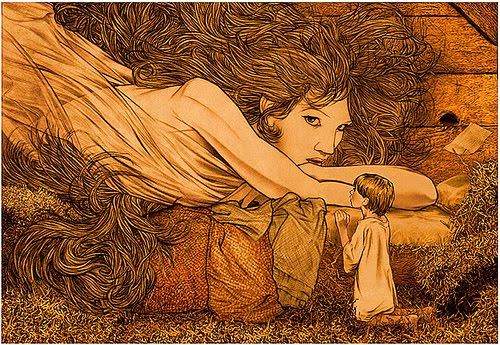Every year, millions of families flock to the Happiest Place on Earth for its infamously well-rounded, old-fashioned entertainment and rides. So many of these individuals will visit Disneyland a mere handful of times in their lives, some even only once. I have the unique privilege of visiting the park at least 3 times a week… and getting paid for it. Just kidding, I work there, but it’s easy to view an hourly job in a truly magical environment as a fun day at the park.
Aside from the colorful atmosphere, which often feels like a movie scene come to life, the most magical part of working there for me definitely has to be interacting with children. Children are so beautiful; I have seen how they easily make friends and accept each other (especially very young children), and their innocence allows them to experience such joy and excitement where adults would be hesitant to express themselves. My favorite thing about children is how imaginative they are. I have had countless conversations with tiny, wide-eyed little boys and girls about their favorite Disney characters, whom they believe without a doubt actually exist. I have seen the imaginary worlds of Disney stories touch the minds and hearts of little ones, teaching them about friendship, love, and hardship through (slightly cheesy) songs, talking animals, and even a queen of a fantasy kingdom who has magical ice powers.
I’ve been thinking a lot lately about how different forms and mediums can communicate truths about concepts that words simply cannot. For example, we communicate to newborns in an array of images, colors, and sounds before they are able to comprehend the meaning of words. But communication through image is not for children alone. One of my favorite professors at Biola University, Dr. Fred Sanders, said in class once that “talking about music is like dancing about architecture. It doesn’t really make sense, but somehow it works.” We’ve all heard the popular phrase, “a picture is worth a thousand words.” This idiom flawlessly expresses that a complex idea or event can somehow be captured in a single image. It is out of this concept that literary allegory is born.
I feel that it is sometimes easy for academics to forget the power of images, songs, and stories to communicate deeper truths. In my last few semesters of finishing my undergraduate degree, for example, I think I may have accrued significant back pain due to carrying around heavy commentaries and Bible dictionaries for the papers I was writing. I was surprised to see that I had been assigned to read a children’s novel during the last semester of my honors program. This semester contained what my professors thought of as the greatest works in the program, including The Brothers Karamazov, Plato’s Phaedo, Four Quartets by T.S. Eliot, and the book of Revelation. Picking up the children’s book, At the Back of the North Wind by George MacDonald, I was simultaneously relieved to have a mental break from these other difficult texts and arrogantly scoffing at the simplicity of the novel. After the first few chapters, however, I was stunned at the beauty and depth of this work.
George MacDonald’s brilliant novel tells the story of a boy named Diamond who is visited at a very young age by a female voice in the barn where he sleeps. The voice identifies herself as the North Wind, and she later appears to Diamond as a tall, pale woman with dark eyes and long hair that flows about her face and body, filling the room. She invites Diamond to journey with her, but he is only wearing a thin nightgown and is worried that he will be cold. The North Wind assures him that “nobody is cold with the North Wind.” “I thought everybody was,” said Diamond. “That is a great mistake. Most people make it, however. They are cold because they are not with the North Wind, but without it.”
The North Wind shows Diamond many things on their journey, and although the North Wind does many good things, such as helping and comforting others, her mission also includes doing things that are ugly and disruptive. She does not appear to everyone as a tall, beautiful woman as she appears to Diamond; she appears as a frightening wolf to a woman and is even given an assignment to sink a ship, with Diamond looking on in disbelief. The North Wind instructs Diamond not to be frightened even if she changes into a serpent or a tiger, for even if she looks like something awful, he must trust that she is “doing her work.”
So who exactly is the North Wind? Her identity is never explicitly disclosed in the novel, but it is revealed that Diamond suffers from some chronic illness, and it is apparent to the reader that he may be close to death. His close friendship with the North Wind and the place he visits at her back indicates that she may be either Death itself, an agent of death, or, what I propose she is: some sort of agent of the providence of God, as she works all things in obedience to her master for the ultimate good of Diamond and the others she knows, even when Diamond does not understand the form she takes. Toward the end of the book, the North Wind tells Diamond the dreadful names she has been called, such as Bad Fortune, Evil Chance, and Ruin, but she says that those who have called her such names do not know her. At one point, Diamond accuses the North Wind of not truly knowing about everything she claims to know about mankind since she does not have a body. She responds with a simple, yet beautiful line, “If I hadn’t, you wouldn’t know anything about me. No creature can know another without the help of a body.”
In this summary, I have barely touched on the depth and beauty of the friendship of the boy Diamond and what he learns from the morphing shapes of the North Wind. As I look back on this past semester, and even my entire undergraduate experience, I recognize this book as teaching me more about the providence of God than I had ever imagined it could, more than I can even explain in words, because as it has taught me, it has increased my faith in my sovereign God. I have been humbled by the truths in this children’s book, and as I continue to interact with hundreds of children on a daily basis at Disneyland, I am reminded of the reason why Jesus implores us in Matthew 18 to “become like little children” in order to enter the kingdom of heaven. If you are looking for a summer read that will touch your soul, explaining in ways that no commentary or dictionary could the confusing concept of theodicy, look no further than At the Back of the North Wind.






2 Comments
Leave your reply.